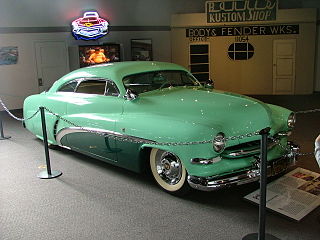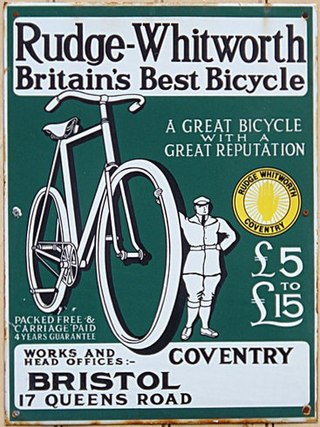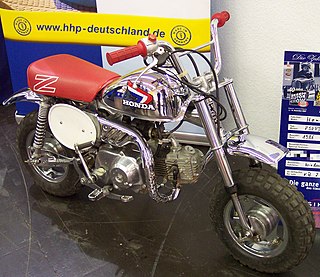Related Research Articles

A bicycle, also called a pedal cycle, bike, push-bike or cycle, is a human-powered or motor-assisted, pedal-driven, single-track vehicle, with two wheels attached to a frame, one behind the other. A bicycle rider is called a cyclist, or bicyclist.

The Honda CB750 is an air-cooled, transverse, in-line-four-cylinder-engine motorcycle made by Honda over several generations for year models 1969–2008 with an upright, or standard, riding posture. It is often called the original Universal Japanese Motorcycle (UJM) and also is regarded as the first motorcycle to be called a "superbike".
A semi-automatic transmission is a multiple-speed transmission where part of its operation is automated, but the driver's input is still required to launch the vehicle from a standstill and to manually change gears. Semi-automatic transmissions were almost exclusively used in motorcycles and are based on conventional manual transmissions or sequential manual transmissions, but use an automatic clutch system. But some semi-automatic transmissions have also been based on standard hydraulic automatic transmissions with torque converters and planetary gearsets.

A custom car is a passenger vehicle that has been altered to improve its performance, change its aesthetics, or combine both. Some automotive enthusiasts in the United States want to push "styling and performance a step beyond the showroom floor - to truly craft an automobile of one's own." A custom car in British usage, according to Collins English Dictionary, is built to the buyer's own specifications.

A centreless wheel or hubless wheel is a wheel that lacks a centre or hub, instead being supported and driven at the rim.

Rudge Whitworth Cycles was a British bicycle, bicycle saddle, motorcycle and sports car wheel manufacturer that resulted from the merger of two bicycle manufacturers in 1894, Whitworth Cycle Co. of Birmingham, founded by Charles Henry Pugh and his two sons Charles Vernon and John, and Rudge Cycle Co. of Coventry.

Yamaha YP 400 Majesty is a scooter made by Yamaha beginning in 2003. The Majesty line includes 150, 250, and 400 cc displacement single-cylinder engine versions available in Europe and Asia. In the US, only the 400 cc model was sold, from 2004 to 2014.
Riding Into History is a non-profit vintage motorcycle event founded in 2000 by Billy Aldrich. It was created in order to celebrate the heritage and history of motorcycles. The event also raised money for designated charities, that have changed over the years. It has now become one of America's premier motorcycle events and the attendance has increased every year.
Motorcycle components and systems for a motorcycle are engineered, manufactured, and assembled in order to produce motorcycle models with the desired performance, aesthetics, and cost. The key components of modern motorcycles are presented below.
The National Motorcycle Museum was a non-profit museum located in Anamosa, Iowa. It was founded in 1989 by motorcycle builders, racers, and riders. Its purpose to maintain the experience of bikes past and present as well as motorcycle memorabilia, documents and actual vintage bikes from as far back as 1903. It was named Iowa Tourism Attraction of the Year in 2001.

The Honda CB1100 is a 1,140 cc (70 cu in) air-cooled inline four-cylinder naked bike that was introduced by Honda in 2010 as a modern spiritual successor to the original CB750. At introduction the motorbike was available in Japan, Australia and New Zealand; it was later introduced to Europe and the United States in 2013.

Simplex Manufacturing Corporation was an American manufacturer that made motorcycles from 1935 to 1975. Between 1935 and 1960, Simplex made variations of the Simplex Servi-Cycle including the 1953–1960 Simplex Automatic. Simplex was the only motorcycle manufacturer located in the Deep South for many years, until Confederate Motorcycles began production.

The following outline is provided as an overview of motorcycles and motorcycling:

The Auto Four is a motorcycle designed and built by engineer and motorcycle enthusiast Wild Bill Gelbke during the early 1970s. Approximately seven examples were built. Gelbke, who had attended engineering school in Wisconsin and at University of Southern California, had worked for McDonnell Douglas and also owned two motorcycle shops in Chicago and Hammond, Indiana. After building his Roadog bike during the 1960s, he wanted to create a more practical large motorcycle for touring and police needs that could go into regular production. As with Roadog, Gelbe constructed and welded the frame himself using 4130 chrome-molybdenum tubing. The bikes were equipped with a BMC A-Series engine and General Motors 4-speed automatic transmission. While the frame and body were custom built by Gelbke, electrical parts, such as headlights and taillights, were sourced from General Motors vehicles, for example the taillights from a 1959 Cadillac. Suspension was sourced from Harley Davidson, particularly hydraglide front forks.
William "Wild Bill" Gelbke was an American engineer and motorcycle designer. He is noted for having designed and constructed large motorcycles powered by automobile engines, particularly the Roadog and the Auto Four, the latter a motorcycle intended for mass production. Roadog was intended to be featured on an episode of The History Channel's Modern Marvels, however the bit was cut from the episode.
Walneck's Classic Cycle Trader was a motorcycle magazine begun in 1978 by motorcycle enthusiasts and swap meet organizers Buzz and Pixie Walneck. The first issues were flyers that listed motorcycle parts for sale; demand for parts and complete motorcycles subsequently resulted in the publication growing into a large, full color magazine that contained over 120 pages during its peak. In 1997 the Walnecks sold the magazine to Trader Publishing, which enabled international distribution. In 2012, it was sold again to Causey Enterprises LLC, who redesigned the magazine extensively, however ceased publishing in 2014. The magazine was established and originally headquartered in Woodridge, Illinois before it was sold to Norfolk, Virginia-based Trader Publishing.

The Dodge Tomahawk is a non-street legal vehicle introduced in 2004
by Dodge at the North American International Auto Show, initially as a one-off concept, and then later that year as a limited production vehicle when DaimlerChrysler announced they would sell hand-built reproductions on order. The Tomahawk attracted significant press and industry attention for its striking design, its outsize-displacement, 10-cylinder car engine, and its four close-coupled wheels, which give it a motorcycle-like appearance. Experts disagreed on whether it is a true motorcycle. The retro-Art Deco design's central visual element is the 500-horsepower (370 kW), 8.3-litre (510 cu in) V10 SRT10 engine from the Dodge Viper sports car. The Tomahawk's two front and two rear wheels are sprung independently, which would allow it to lean into corners and countersteer like a motorcycle.

The Honda Z50RD, also known as the Christmas Special or the Chrome Edition, is an all-chrome Honda Z series minibike released in 1986. A limited edition of the Honda Z50R, it is considered to be rare.

The Laverda 750SFC is a hand-built 744 cc (45.4 cu in) air cooled SOHC 4 stroke parallel twin production racing motorcycle produced by the Italian manufacturer Laverda from 1971-1976. It was developed from the company's 750SF and drew from the racers used at the 1970 Bol d'Or. Finished in orange with a distinctive half-fairing, the machine was made in batches, with each batch identified by the frame number range. In total 549 SFCs were manufactured.
The Kawasaki e-1 is an electric motorcycle produced by Kawasaki, which markets it in two variants: a naked Z e-1 and a Ninja e-1 sport bike with fairing.
References
- 1 2 3 4 5 6 7 Mueller, Jim (July 8, 2001). "It ain't nothin' but a Roadog". Chicago Tribune. Retrieved 14 April 2016.
- ↑ Walneck, Buzz. "What in the World is "Roadog"?". walneckswap.com. Retrieved 14 April 2016.
- 1 2 3 "Roadog". Museum Archives. Museum of Science and Industry. Archived from the original on February 24, 2004. Retrieved 14 April 2016.
- ↑ Constantine, Craig (January 2003). "Revealed". Cycle World Magazine. Cycle World. Retrieved 3 May 2024.
- ↑ "RoaDog Lives at the National Motorcycle Museum". 30 April 2016.
- ↑ Constantine, Craig (January 2003). "Roadog Revealed". Cycle World. Retrieved 15 April 2016.
- ↑ "I Bought the Legendary "ROADOG" Motorcycle(to Ride)". YouTube . Retrieved 20 October 2023.
- ↑ Can We Revive AND RIDE The World's Biggest Motorcycle? (17 feet long) , retrieved 2023-10-21
- ↑ "Wheels Through Time Museum". Wheels Through Time. Retrieved 2023-10-21.